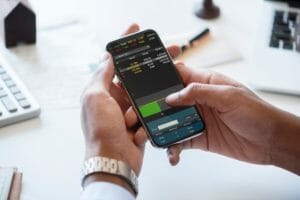Written By: Luke Erickson
 |
There are so many things you can do with a Smartphone that it can be unsettling when you see someone actually talking on one. Between Androids and iPhones there are now over 5 million apps that have been downloaded a cumulative total of 140 billion times (Picoto, Duarte & Pinto, 2019). Some are amusing, some are quirky, some are a complete waste of digital space, and then every once in a while you come across a gem. No, not Bejeweled, but an app that is truly useful and makes you wonder how you ever lived without it.
But what about financial apps? Are they worth your time? And, is there really anything so wrong with the good old-fashioned way of managing money? You can decide for yourself. But consider first that the financial world has grown increasingly complex over the last few decades. For example, credit scores are more vital to a person’s financial well-being than ever before, impacting not only future loans, but also insurance premiums and employment opportunities, among other things. There are serious consequences for those who fail to keep up. Additionally, an increasing amount of financial products and services are being delivered electronically. What better way than apps to keep up with the increasingly tech-laden financial landscape. Finally, clientele of all demographics are increasingly using their phones to manage their finances, including the unbanked. As a financial professional, if you can’t communicate with your clients on this level you may be doing them a tremendous disservice.
Ok, ok…you’re convinced now to pay at least some attention to financial apps, but where do you start? There are literally thousands of personal finance apps out there. You probably don’t have time to try them all. Instead consider that most financial apps can be sorted into the following ten categories:
-
- Allowance. With options to link to chores and real bank accounts or to use virtual “Mom and Dad” currency, these apps help parents and kids manage allowance in some fun and engaging ways. Examples include Moneytrail.net, Rooster Money and Famzoo.
- Financial education. Includes educational games, financial news, reading, etc. Examples include Clark Howard on Demand, Visa Football, and Night of the Living Debt (full disclosure, this is one the author helped develop and it’s pretty awesome, available on iPad iOS).
- Debt reduction. The debt snowball right in your pocket. Examples include PowerPay, Student Loan Hero, and Debt Payoff Assistant.
- Shopping guides and calculators. Find good deals, save money and determine affordability of big-ticket items. Examples include: Layers, Red Laser, Retail Me Not, Groupon, and University Lunchbox.
- Credit monitoring. Stay on top of that all-important number. Examples include Credit Karma and Credit Sesame.
- Investing. Make trades right from your phone. Examples include: Acorns, Robinhood, Coinbase.
- General budgeting and goal setting. Set goals, track expenses and receipts, set spending limits, automate savings, track net-worth, etc. Examples include: Mint, YNAB, Wally, Personal Capital, Every Dollar and Qapital.
- Taxes. Get your tax questions answered and file right from your phone. Examples include: IRS2Go, TurboTax, H&R Block and TaxSlayer.
- Mobile payments. Examples include Paypal, Venmo, Facebook Messenger, Google Pay, Apple Pay and Zelle.
- Bank and insurance companies. Pretty much all national and local banks, insurance companies and other financial service companies allow you to do business through apps. Examples include State Farm, Bank of America, USAA, Discover and Zion’s Bank.
But what about FinTech phobia? One of the main reservations to using financial apps is their safety and security. This is a legitimate concern, particularly with the rapidly increasing adoption of e-wallets used for mobile payments (Kaur, Li, Iqbal, Gonzalez, & Stakhanova, 2018). According to Chen, Meng, Su, Fan, Xue, Liu, & Hao (2018), the main security concerns are “outdated versions of banking apps, pollution from third-party libraries, and weak hash functions.” The good news is that the basic rules apply to phones as well as to computers. First, have a secure password that locks them in the event that they are lost or stolen. Be cautious when using public Wi-Fi. Some risks are out of our hands, such as an app developers’ or financial companies’ internal data management practices and history of data breaches, however most of the major apps that ask for personal financial information are backed by major companies with reputations to uphold, and they use the same encryption technology as the major banks. In short, the use of technology in financial transactions and money management is ubiquitous. While using apps and phones seems new, it is merely an extension of what we have already been doing for decades – that is allowing computers of some form to help us manage and track our money. The adoption of smartphone apps for money management among our clientele is continuing to grow. Are we keeping up?
References
Chen, S., Meng, G., Su, T., Fan, L., Xue, Y., Liu, Y., … & Hao, S. (2018). Ausera: Large-scale automated security risk assessment of global mobile banking apps. arXiv preprint arXiv:1805.05236.
Henderson, W. (2016). Direct Express mobile app delivers financial capability to those in most need. U.S. Treasury https://www.treasury.gov/connect/blog/pages/direct-express-mobile-app-delivers-financial-capability-to-those-most-in-need.aspx
Kaur, R., Li, Y., Iqbal, J., Gonzalez, H., & Stakhanova, N. (2018, July). A Security Assessment of HCE-NFC Enabled E-Wallet Banking Android Apps. In 2018 IEEE 42nd Annual Computer Software and Applications Conference (COMPSAC)(Vol. 2, pp. 492-497). IEEE.
Picoto, W. N., Duarte, R., & Pinto, I. (2019). Uncovering top-ranking factors for mobile apps through a multimethod approach. Journal of Business Research.